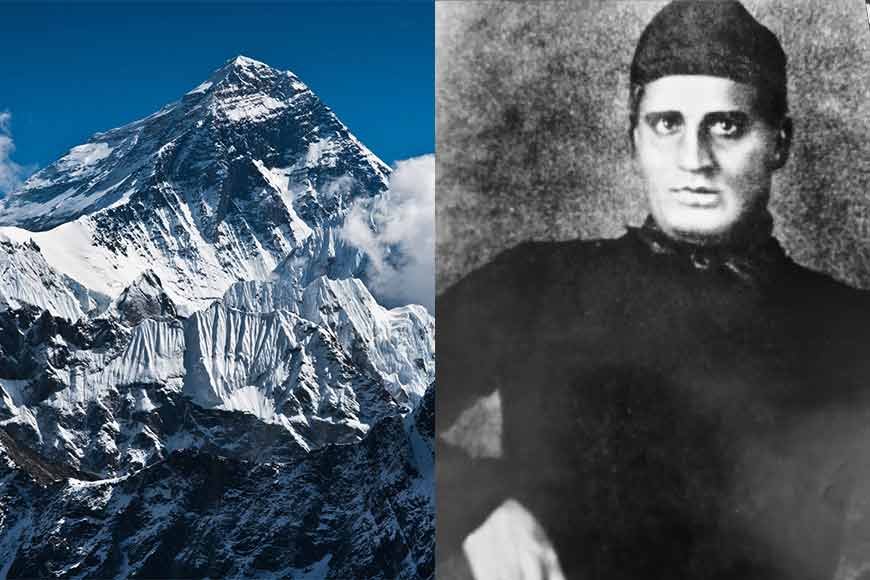First to record the height of Mt. Everest

It still rises half a metre per century. In a joint statement last week, China and Nepal announced the highest point on Earth, Mount Everest’s height has changed as per a recent survey. Geologists believe that a severe earthquake that hit Nepal in 2015, might be the reason for increase in the height of Mt Everest. All said and done, modern surveyors are armed with the latest sophisticated computerized instruments, GPS etc. while centuries back one Bengali mathematician had correctly calculated the height only through mathematical analysis
A proposal had been mooted by Sajal Kumar Guha, convener of Antarjatik Bangla Bhasha O-Sanskriti Samity, Siliguri in 2017. He sent a letter to the central government to consider sending a proposal to the UNESCO to rename Mt Everest as Mt Radhanath. Members of the society asked the Union Defence Minister to keep the ‘historical perspective’ in mind and change the name of the summit.
Radhanath Sikdar, a mathematician from Bengal was a genius per se. He first recorded the height of Mount Everest. But the British empire hid his name and attributed the great discovery to Sir Andrew Scott Waugh, who was the director of Survey of India at the time. The official assessment of the height of Mount Everest was first done by the Survey of India during the colonial rule. This agency was established to create an official map of India. In 1830, Sir George Everest became the director of Survey of India and in 1831, he appointed Radhanath Sikdar, to the post of ‘Computer’ in the Survey of India.
Computers were not invented at that time. All calculations were done by humans and such people were called ‘Computer’ in the Survey of India. The team of Survey of India reached close to the Himalayan range in the 1830s. At that time, the peak of Kangchenjunga mountain was considered to be the highest mountain peak in the world. In 1852, Radhanath Sikdar started the work of measuring the mountain peak named ‘Peak 15,’ a name by which Mount Everest was then known by. Andrew Scott Waugh, the then director of Survey of India, examined Radhanath Sikdar’s assessment for four years. Scott had worked with Sir George Everest, former director of Survey of India and considered him his mentor. That is why he sent a proposal to rename 'Peak 15' mountain peak to ‘Mount Everest’ to the Royal Geographical Society of Britain.
Thus the credit for measuring the official height of Mount Everest was taken away from Radhanath Sikdar and the highest mountain peak in the world was named after an Englishman. The British government tried its best to hide this information. Despite this, the great discovery of Radhanath Sikdar could not be hidden. In 1966, the information about Radhanath Sikdar's success was also given in the Indian Journal of History of Science.
Radhanath Sikdar, a mathematician from Bengal was a genius per se. He first recorded the height of Mount Everest. But the British empire hid his name and attributed the great discovery to Sir Andrew Scott Waugh, who was the director of Survey of India at the time.
A proposal had been mooted by Sajal Kumar Guha, convener of Antarjatik Bangla Bhasha O-Sanskriti Samity, Siliguri in 2017. He sent a letter to the central government to consider sending a proposal to the UNESCO to rename Mt Everest as Mt Radhanath. Members of the society asked the Union Defence Minister to keep the ‘historical perspective’ in mind and change the name of the summit. Sajal Guha was an ex-employee of the central defence ministry. From 2002 to 2005, for two-and-a-half years, he was sent on deputation to work in the accounts department of HMI (Himalayan Mountaineering Institute). Here he came across Tenzing Norgay’s son Jamling Tenzing, Norgay’s nephew Nowang Gombu, five-time Everest climber Kushang Dorji Sherpa, Lattu Dorji, Nadre Sherpa, Miss Kunga Bhutia, T.B. Budhatki, Amar Singh and many others who scaled the peak. From here he got to know how a Bengali mathematician’s glorious find was hijacked by the British.










